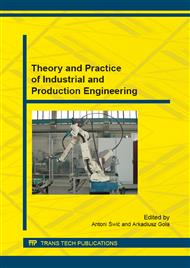[1]
S. Wang, R.S. Timsit, J.K. Spelt, Experimental investigation of vibratory finishing of aluminum, Wear, 243 (2000) 147-156.
DOI: 10.1016/s0043-1648(00)00437-3
Google Scholar
[2]
D. Ciampini, M. Papini, J.K. Spelt, Modeling the development of Almen strip curvature in vibratory finishing, Journal of Materials Processing Technology, 209, 6 (2009) 2923-2939.
DOI: 10.1016/j.jmatprotec.2008.06.060
Google Scholar
[3]
M.R. Baghbanan, A. Yabuki, R.S. Timsit, J.K. Spelt, Tribological behavior of aluminum alloys in a vibratory finishing process, Wear, 255, 7-12 (2003) 1369-1379.
DOI: 10.1016/s0043-1648(03)00124-8
Google Scholar
[4]
Y. Wang, D. Hu, Study on the inner surface finishing of tubing by magnetic abrasive finishing, International Journal of Machine Tools and Manufacture, 45, 1 (2005) 43-49.
DOI: 10.1016/j.ijmachtools.2004.06.014
Google Scholar
[5]
K.I. Jang, D.Y. Kim, S. Maeng, W. Lee, J. Han, J. Seok, Deburring microparts using a magnetorheological fluid, International Journal of Machine Tools and Manufacture, 53, 1 (2012) 170-175.
DOI: 10.1016/j.ijmachtools.2011.11.002
Google Scholar
[6]
S.L. Ko, Y. M. Baron, J.I. Park, Micro deburring for precision parts using magnetic abrasive finishing method, Journal of Materials Processing Technology, 187-188 (2007) 19-25.
DOI: 10.1016/j.jmatprotec.2006.11.183
Google Scholar
[7]
V. K. Gorana, V. K. Jain, G. K. Lal, Experimental investigation into cutting forces and active grain density during abrasive flow machining, International Journal of Machine Tools and Manufacture, 44, 2-3 (2004) 201-211.
DOI: 10.1016/j.ijmachtools.2003.10.004
Google Scholar
[8]
L. Dąbrowski, M. Marciniak, W. Wieczorek, A. Zygmunt, Advancement of Abrasive Flow Machining Using an Anodic Solution. Journal of New Materials for Electrochemical Systems, 9 (2006) 439-445.
Google Scholar
[9]
L. Fang, J. Zhao, K. Sun, D. Zheng, D. Ma, Temperature as sensitive monitor for efficiency of work in abrasive flow machining, Wear, 266, 7-8 (2009) 678-687.
DOI: 10.1016/j.wear.2008.08.014
Google Scholar
[10]
J.C. Aurich, D. Dornfeld, P.J. Arrazola, V. Franke, L. Leitz, S. Min, Burrs-Analysis, control and removal, CIRP Annals - Manufacturing Technology, 58, 2 (2009) 519-542.
DOI: 10.1016/j.cirp.2009.09.004
Google Scholar
[11]
J. Matuszak, K. Zaleski, Edge states after wire brushing of magnesium alloys. Aircraft Engineering and Aerospace Technology, 86, 4, (2014) 328-335.
DOI: 10.1108/aeat-09-2012-0155
Google Scholar
[12]
J. Matuszak, K. Zaleski, Effect of brushing parameters upon edge states after wire brushing of AZ91 HP magnesium alloy, Advances in Science and Technology, 20, 7 (2013) 55-60.
DOI: 10.5604/20804075.1073058
Google Scholar
[13]
J. Matuszak, K. Zaleski, Effect of cutting fluids upon surface quality after wire brushing of 7075 aluminium alloy, in. P. Rusek (Ed. ), Innovative Manufacturing Technology, Kraków, 2012, pp.203-214.
Google Scholar
[14]
Zaleski K., Matuszak J.: Patent application P. 405625, A method and device for diameter determination of circular brushes, Patent application accepted at Polish Patent Office in 2013-10-14.
Google Scholar


